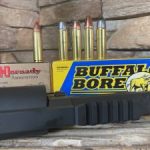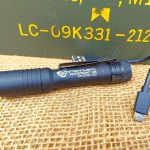Vortex AMG UH-1 Gen 2 “Huey” — A Versatile Holographic Sight
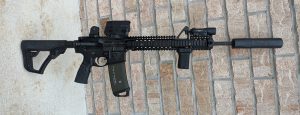
Over the last decade, Vortex has earned a reputation as a venerable staple of the optics market. I was first acquainted with Vortex when they suddenly materialized in the gun store I worked at in 2012. I was immediately impressed by the clarity of the lenses on a set of display binoculars. In side-by-side comparison with other high-quality binoculars, some in excess of $700 at the time, I was blown away by the price-to-quality ratio offered. Vortex’s lifetime warranty is no slouch either.
I’ve relied on a Vortex handheld monocular for law enforcement surveillance for nearly 10 years without any hiccups. My Alamo Precision .308 is outfitted with a Vortex Viper 4-16x50mm while my patrol rifle is equipped with a Vortex Strikefire II. To say I’ve had some experience with Vortex optics is appropriate, if not an understatement.
Recently, I got my hands on one of Vortex’s more interesting entries into their optics lineup — the Vortex AMG UH-1 Gen 2 Holographic sight, colloquially nicknamed the “Huey.” I’ll admit I wasn’t sure what to expect when I received the optic. I’ve ventured into holographic sights in the past but primarily dedicated myself to the extended battery life and apparent simplicity provided by red dot optics. An entire article can, and will, be dedicated to comparing the two designs but is outside the scope of most folk’s attention span (I’m not exempt from this) and this review. Ultimately, the UH-1 is a well-designed and rugged holographic sight at a competitive market price ($600).
The Vortex AMG UH-1 Gen 2
Holographic sights are nothing new since the introduction of the Holosight in 1996. Vortex began their venture into holographic sights by adding the UH-1 Razor to their lineup in 2017 as a direct competitor to other holographic sights like those offered by EOTech. In 2020, Vortex stepped up their game by offering a night vision compatible design with the Gen 2 Huey.
The Vortex AMG UH-1 Gen 2 Huey came complete with an instruction manual and an included CR123 battery. Battery installation was quick as the optic offers a folding “turnkey” for easy battery installation and removal. While on the topic of batteries, I should address the elephant in the room as it relates to holographic sights: their battery life pales in comparison to standard red dots. Depending on brightness settings, a holographic sight will only get between 500 to 1,000 hours of life compared to the 50,000+ hours of battery life from red dot single diode emitter. This is arguably the biggest con of any holographic sight, but it’s offset by certain benefits offered by the holographic design.
The Gen-II has the addition of an “NV” or night vision setting that is compatible with most modern night vision optics. The Gen-II deleted the rechargeable feature offered on the original Huey. I attribute this primarily to complaints heard on the use of rechargeable batteries and the diminished battery life some users reported. Nevertheless, CR123 batteries are common and easily acquired at reasonable prices in bulk.
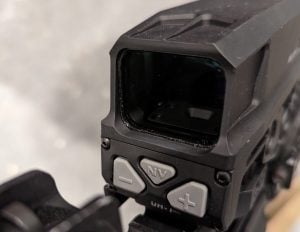
Mounting the optic to an AR-15 was a breeze as it affixed directly to a standard Picatinny M1913 rail via an adjustable tension throw level. The lack of screws to adjust tightness gave me extra piece of mind that it wouldn’t fly off under heavy use nor did I have to get the tension “exact” to ensure a screw didn’t work its way out.
Sight-in and Adjustments
Sight-in was a breeze as the ½ MOA adjustments got me on paper at 50 yards relatively quickly. The optic was easily sighted in at 50 meters which, in my opinion, is the far range for precision sub-MOA shooting with a red dot. The rifle provided approximately 1.5 MOA groups at 50 yards, which isn’t necessarily precision quality, but is good enough for the test at hand.
I conducted MOA adjustment testing on the optic to determine if the optic tracked appropriately. The MOA adjustment testing involved what I refer to as the “Box Drill”. For those unfamiliar with a box drill, it involves sighting the optic in on a target at any distance between 25-100 meters. The target has four additional targets positioned at the corners of the center target in a “X” pattern. Each of the corner targets are 4” apart from each other and exactly 2” offset by elevation and windage from the center target.
A properly tracking optic with ½ MOA adjustments, like the Huey, should require four clicks left or right and four clicks up or down to hit one of those corner targets if I’m sighted on the center target at 100 yards. It’s an easy test to determine if internal adjustments are accurate, affected by recoil, or the scope has another internal issue. In summary, the Huey tracked exactly as it should within the 1.5-2 MOA margin for error I experienced with the initial 3-shot group. With my concerns assuaged about the optic maintaining zero or adjusting properly, I delved into my stash of ammo for testing.
Housing and Sight Picture
The housing on the UH-1 appears well-built and the phrase “overbuilt” almost comes to mind. This is an optic I have little concern over being able to withstand impacts from heavy use. During initial testing, a thunderstorm moved in and soaked the rifle and Huey with a nice rain. This had no effect on the optic’s performance and it continued working without a hiccup.

The optic’s profile was compact despite its apparent size. The weight, at 11.6 ounces, was not an issue due to its location near the center of mass on the rifle. While not being the first to note this, the optic’s profile is narrower near the rear objective and opens up at the front. This allows the large optic window to nearly disappear during use and doesn’t appear to impede the view of the target. It’s a nice little feature most users may not notice unless they pay close attention to it.
Reticle on the UH-1
As a red dot enthusiast, I’m used to the vanilla sight picture of a single dot offered by the reflected diode. Put dot on target and press trigger is the normal prescription for red dot applications. However, there is substantially more involved when dealing with an AR-15 optic. The optic on an AR-15 is not mounted directly in line with the bore and requires significant offset from the barrel.
For example, a 5.56 AR-15 pattern rifle sighted in at 100 meters can easily maintain head shots on a silhouette target to about 15 meters. As the shooter moves closer to the target, where the optic is sighted in versus where the projectile goes, begins to deviate. This isn’t so much about the trajectory of the bullet as much as it’s about the offset (between 1.5 to 2 inches) between the optic and the rifle bore.
This is why, somewhat hilariously, I’ve seen officers shoot barricades and even vehicles during training because the optic showed a clear view of the target while the barrel was not cleared from the obstacle. In the real world, this can lead to tragic consequences if the shooter isn’t conscious of this. Case in point, a shot on a hostage taker at close distances requires the shooter to aim their optic above the anticipated impact point. Historically, this is achieved through repetitive training and knowing what the offset is at closer distances.

The Huey is equipped with Vortex’s EBR-CQB reticle – a 65 MOA circle with 1 MOA dot. The small dot allows for precise shots to the user and rifle’s capabilities while the 65 MOA circle makes for fast hits on target at short ranges. From my experience, the most beneficial feature this reticle offers is the small CQB triangle in the lower portion of the optic. Vortex advertises the CQB triangle as offering the shooter a quick point-of-aim/point-of-impact reference for the optic-to-bore offset discussed earlier at distances of 10 meters or less. Using a homemade IPSC target, I conducted drills between seven and 50 meters using the provided reticle.
At distances of 15 meters or less, the CQB triangle was a handy addition when performing precision “hostage taker” shots while the 65 MOA circle made getting the optic on target and scoring hits center mass an easy task. The 1 MOA dot made for easier precision shots at distance. For those involved in competition, defensive, or similar applications, this reticle design was easy to adjust to after years as a lowly red dot user. After several hundred rounds, the optic continued to hold zero with no apparent issues or malfunctions.
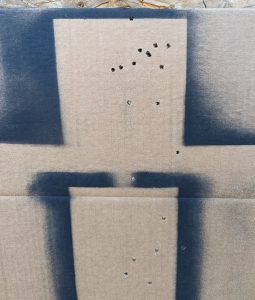
Final Thoughts on the Vortex AMG Gen 2
The Vortex AMG Gen 2 Huey is a fantastic optic on par with other available holographic sights. The diminished battery life of the holographic sight versus a red dot is overcome by the crisp clean image provided by a holographic sight. Even at its highest setting, the reticle didn’t “starburst” or blur due to the brightness as seen with some red dots. For those with astigmatism, a holographic sight like the Huey is an excellent option as the starburst issue of red dots is averted.
While battery life is a concern, the Huey features an auto-off feature where it turns off after 14 hours of continuous on. If Vortex is to improve on their design at all, I would suggest they include a “shake-awake” feature on the optic like other manufacturers have developed to automatically turn the optic on when the weapon is moved. This feature is neat, but also presents some issues in a military or law enforcement capacity where the weapon and optic are stored in a vehicle. The movement of a vehicle during a pursuit or other fast and furious driving could inadvertently turn the optic on. While I’ve been in a hurry to deploy my patrol rifle; the rifle is stored with a loaded mag and empty chamber. I’ve trained to charge the rifle, turn the optic on, and check the reticle to make sure it’s functioning with my previous red dots. I feel the need to turn the optic on is less of a feature issue with the optic than a training issue with the user. If the user trains appropriately, turning the optic on while deploying the rifle takes barely more time than is necessary to charge the rifle with a live round.
Ultimately, the Huey is a solid optic that I look forward to getting more time on over the coming months. I’ve been impressed enough with its performance that I plan to put it on my full-time patrol rifle for duty use. And, barring the optic spontaneously self-destructs, I anticipate many years of service. Overall, the Vortex AMG UH-1 Gen 2 Huey is another well-built addition to the quality lineup of Vortex optics.
The post Vortex AMG UH-1 Gen 2 “Huey” — A Versatile Holographic Sight appeared first on The Mag Life.

